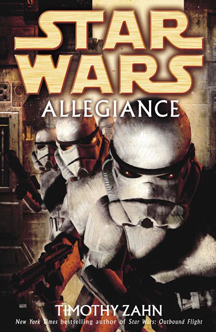As “Rebels” moves the Disney timeline into the era of non-clone stormtroopers, it’s a good time to look back at the definitive novel about Legends stormtroopers, Timothy Zahn’s “Allegiance” (2007). More than merely allowing a reader to relate to the bad guys by telling the story from their perspective, “Allegiance” makes a strong case that the particular Imperials we follow here – five stormtrooper deserters in one thread, and Emperor’s Hand Mara Jade in another — actually ARE good guys.
In both cases, the Imperials believe they are serving the side of what is good and right. And indeed, if the entire Empire was made up of people like them, it would arguably be a fair and just government. The main problem, of course, is that centralized government tends toward power for power’s sake and allows for complex layers of corruption. Additionally, a huge collection of laws makes citizens fear that they are always breaking some sort of law and are at the mercy of an officer’s discretion. Even if every officer in the Empire enforces only the reasonable laws and ignores the unjust ones, such a system is inherently immoral.
The five stormtroopers – LaRone, Marcross, Quiller, Grave and Brightwater – learn the chilling truth about the Empire on the appropriately named planet Teardrop, where they are ordered to murder a town full of innocent civilians after the Rebels split town. When LaRone questions Major Drelfin, he’s forced to defend himself and Drelfin is killed. Knowing they’ll be executed by the Empire, the five troopers head off on their own. This is a more complex answer to the fairly straightforward tale of Biggs Darklighter’s desertion in the “Empire” comics. Knowing they can’t return to the Empire even if they want to, these ex-stormtroopers do various good deeds and label themselves the Hand of Judgment. And they increasingly question the Empire, as in this exchange on page 31 of the hardcover:
Grave: “(A)fter what happened on Teardrop, I’m not sure I’ll ever be comfortable wearing my armor again.”
Quiller: “And as for leaving the Empire, it seems to me the Empire left us first. At least the Empire we thought we were signing up to serve.”
Mara, whom LaRone judges as naïve, believes that any glitches in the Imperial system can be fixed from the inside. On page 324, she thinks:
LaRone could talk all he wanted about these scattered abuses of power, and certainly those abuses needed to be dealt with. But as long as the Empire could still produce men like General Deerian (a good Imperial whom Mara met earlier in the book), it would be worth defending.
Mara hasn’t had the same horrifying experiences as LaRone and his group, but that’s not the whole explanation for her view. She believes she can root out internal corruption because she herself is so good at it. Indeed, this is her earliest appearance in a novel (“Allegiance” is set between “A New Hope” and “The Empire Strikes Back”), and 18-year-old Mara is already outstanding at rooting out corrupt Imperials. Zahn doesn’t paint her as being too perfect, as Mara does make her share of tactical mistakes, but with the way everyone marvels at her considerable Force skills, it’s understandable why she has risen to the rank of Emperor’s Hand.

(On a side note, Zahn seems to like the term “Hand.” The Emperor’s Hand and the Hand of Judgment are of no relation, although it gives a nice symmetry to their brief alliance here. And the Hand of Thrawn and its related Empire of the Hand — the government of Chiss space that we learn about in the “Hand of Thrawn” duology and “Survivor’s Quest” — are not connected to Mara or these stormtroopers here. But later — by sheer coincidence, and again, providing a nice symmetry — the Hand of Judgment ends up joining the Empire of the Hand. Whew.)
As is his style, Zahn tells separate stories that converge by book’s end. “Allegiance” finds Luke, Han and Chewbacca bound for Shelkonwa to investigate pirating; Leia heads there to meet with possible allies; and Mara is on her way there to investigate corruption. But we know Mara can’t meet her future husband and friends, so it’s similar to how Anakin can never meet Grievous in “The Clone Wars.” Zahn is kind of winking at the readership, and it’s amusing.
But when he’s boxed in by these continuity constraints, the author feels a need to make the connections complex enough to be believable – essentially to earn the concept of Mara and Luke being in the same story years before they meet. While I felt “Choices of One” (the sequel to “Allegiance”) and “Scoundrels” – both of which are also set during this timeframe – were too confusing, I was able to follow “Allegiance.”
The main reason I liked this book, though, is the characterizations. In addition to fleshing out Mara’s days as the Emperor’s Hand and getting under the helmets of five noble stormtroopers, Zahn nails the traits of Luke as a novice Force-user being guided by Obi-Wan’s voice. I had to chuckle at a passage on page 209, when Obi-Wan tries to guide Luke to sense an Imperial code via the Force but Luke struggles: “There was a whisper in (Luke’s) mind that might have been a sigh.” And then Obi-Wan simply tells Luke the code.
“Allegiance” is a key book in Han’s gradual switch from on-the-fence to loyal Alliance member. Leia pitches Han the notion that he should join the Rebellion for an individual, if not for idealism, then takes him off guard by saying that individual is Chewbacca. “Or maybe even someone else,” Han thinks, as Zahn provides a building block in the Leia-Han romance. And an amusing continuity note comes when Mara suggests that Vader keep an eye on Captain Ozzel (whom Vader will strangle in “Empire”), who attempts to cover up the five stormtroopers’ desertion.
While the story isn’t as galaxy-shaking as Zahn’s post-“Return of the Jedi” novels, “Allegiance” nicely illustrates Imperial corruption and the politics of rebellion. And while the plot shows signs of the convolutions that would mar his later works, I can forgive that because this is Zahn’s best exploration of characters — his own creations and the film favorites.

